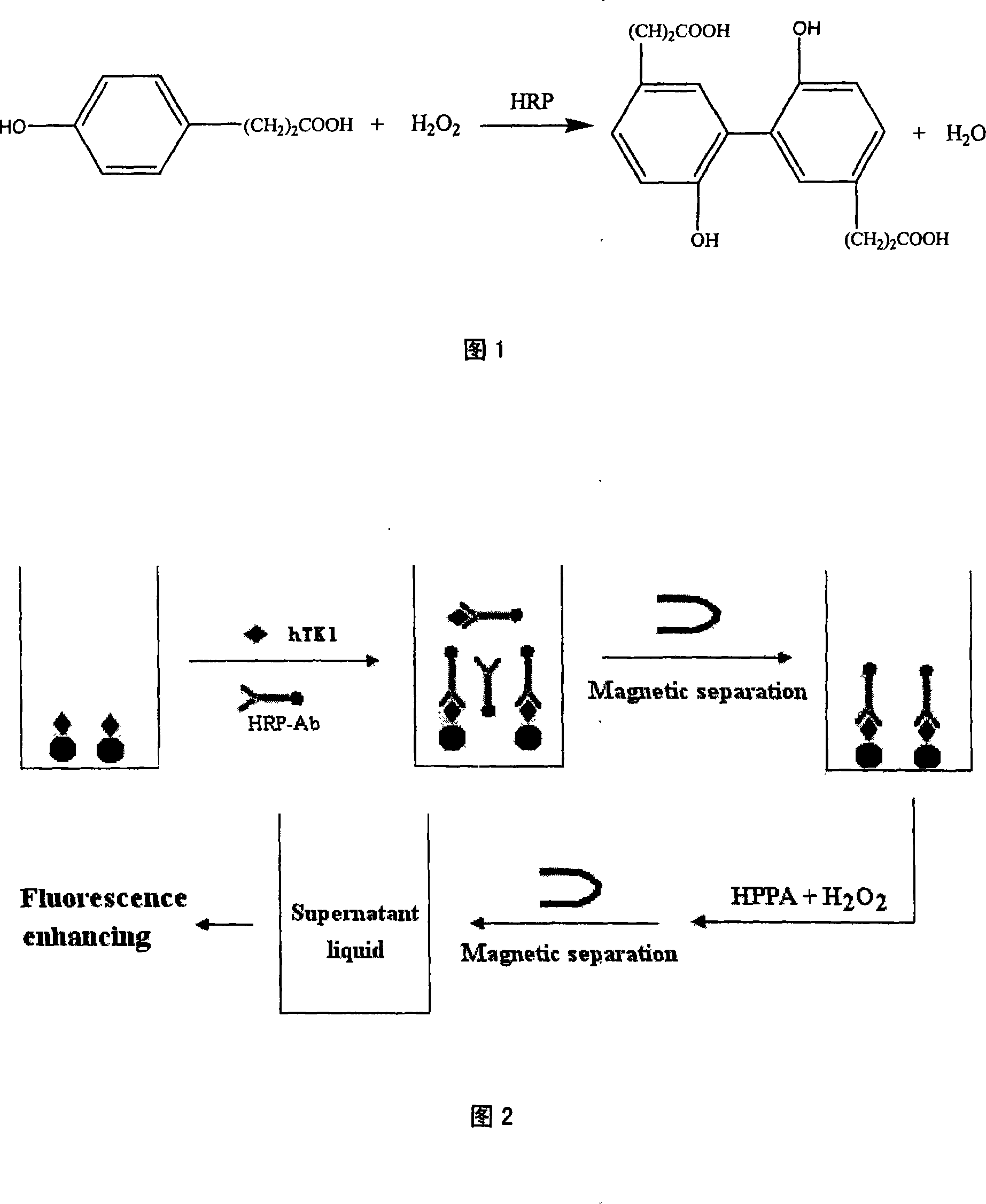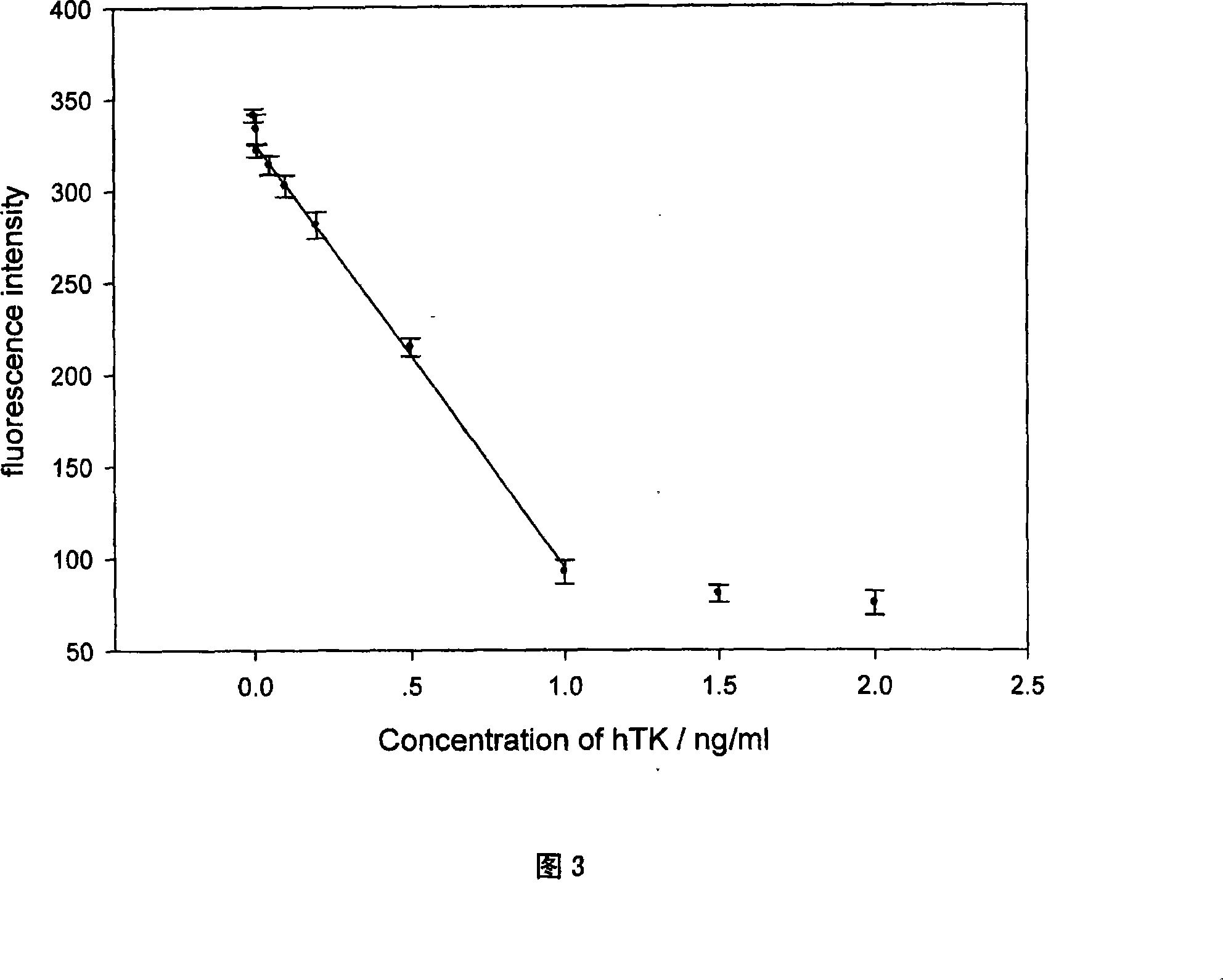Novel method for analyzing human thymidine kinase fluorescence immune based on magnetic nanometer particular
A fluorescent immunoassay and magnetic nanoparticle technology, applied in the field of clinical medical assay and detection and analysis, can solve the problems of complex process and long time, and achieve the effect of simple operation, simple method and uniform nanoparticles.
- Summary
- Abstract
- Description
- Claims
- Application Information
AI Technical Summary
Problems solved by technology
Method used
Image
Examples
Embodiment 1
[0054] Preparation of core-shell magnetic particles coated with hTK1
[0055] ① Preparation of magnetic nanoparticles (MNPs): Accurately weigh 0.59g FeCl 3 ·H 2 O and 0.40FeCl 2 4H 2 O was dissolved in 4ml of 2M HCl so that the concentrations were 0.82M and 0.43M, respectively. Quickly mix in a 250ml three-necked flask, then quickly dropwise add 40ml of 1M ammonia water, add 0.0202g of ascorbic acid (analytical pure) after 5min, stir for 30min, static layer and remove the supernatant, add 1.5ml of 25% tetramethylhydrogen Ammonium oxide (analytically pure) solution was stirred for 10 minutes, added distilled water to make the total volume 40ml, ultrasonically oscillated for 15 minutes, filtered with a sand funnel, and large particles were removed to obtain magnetic nanoparticles, and a beige magnetic nanoparticle solution was obtained.
[0056] ② Aminosilanization of magnetic nanoparticles: Mix 1ml of magnetic nanoparticles with 100ml of isopropanol and sonicate for 30min, ...
Embodiment 2
[0062] Detection of hTK1
[0063] Take 20 μl hTK1 solution of different concentrations (0-2.0ng / ml) and 10 μl 50ng / ml horseradish peroxidase-labeled hTK1 monoclonal antibody (by immunizing Balb / C with human thymidine kinase expressed and purified in Escherichia coli). Mice, splenocytes of immunized mice were fused with myeloma cells, HAT selection culture and ELISA screened positive clones, the hybridomas of positive clones were injected into the peritoneal cavity of mice to prepare ascites, and then purified) and reacted for 40 minutes, then added 10 μl of magnetic nanoparticles labeled hTK (hTK1-MNPs), reacted at 37°C for 40 minutes, washed three times with phosphate buffer solution (pH=7.4), separated under the action of a magnetic field, dispersed in 10 μl pH=7.4 phosphate buffer solution, and added 150 μl pH5.5 phosphate buffer solution, 20 μl 4.4×10 -4 M HPPA and 20 μl 8.8 × 10 -4 M H 2 o 2 , reacted for 30 min, under the action of a magnetic field, use a micro-sampl...
PUM
 Login to View More
Login to View More Abstract
Description
Claims
Application Information
 Login to View More
Login to View More - R&D
- Intellectual Property
- Life Sciences
- Materials
- Tech Scout
- Unparalleled Data Quality
- Higher Quality Content
- 60% Fewer Hallucinations
Browse by: Latest US Patents, China's latest patents, Technical Efficacy Thesaurus, Application Domain, Technology Topic, Popular Technical Reports.
© 2025 PatSnap. All rights reserved.Legal|Privacy policy|Modern Slavery Act Transparency Statement|Sitemap|About US| Contact US: help@patsnap.com


